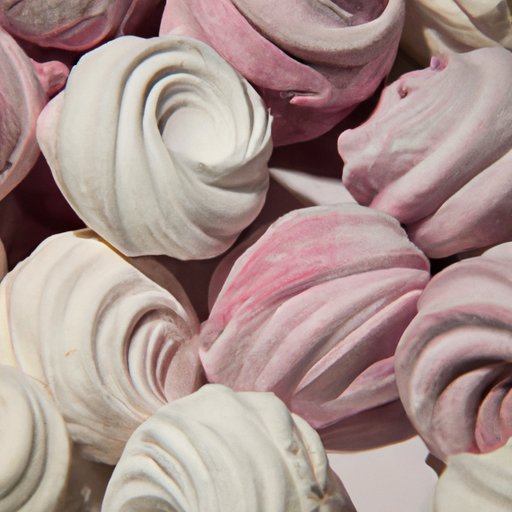Introduction
Marshmallows are one of the most popular treats around the world, loved by both kids and adults alike. These fluffy sweets have been a staple of camping trips, hot chocolate, and dessert tables for generations. But have you ever wondered exactly what marshmallows are made of? In this article, we’ll delve into the sweet science behind these confections, explore their ancient and modern history, and provide some creative recipes to try out at home.
The Sweet Science Behind Marshmallows: Understanding the Ingredients and Process
Marshmallows are essentially a mixture of sugar, gelatin, corn syrup, and flavorings that are whipped together to create fluffy, cloud-like marshmallows. The sugar content in marshmallows is quite high, but it’s the gelatin that gives them their unique texture. Gelatin is a protein extracted from animal collagen, and when mixed with hot sugar syrup and whipped, it creates that characteristic airy, spongy texture. Corn starch is used to prevent the marshmallow mixture from sticking together, while various flavorings, such as vanilla, peppermint, or strawberry, give marshmallows their distinct taste.
Making marshmallows from scratch is a relatively simple process, but it requires precision and patience. First, gelatin is added to water and allowed to bloom for a few minutes. Next, sugar syrup is heated up to 240°F (115°C) before being mixed with the bloomed gelatin. The hot mixture is then whipped until it becomes light and fluffy – a process that can take anywhere from 10 to 20 minutes. Finally, the marshmallow mixture is poured into a pan coated with cornstarch and left to set for several hours.
From Ancient Roots to Modern Treats: Exploring the History of Marshmallows
Marshmallows have a long and rich history, dating back to ancient Egypt, where they were used as a medicinal treatment for sore throats and other ailments. It wasn’t until the 19th century, however, that marshmallows began to be produced on a large scale in France. At the time, marshmallows were made with extracts from the marshmallow plant, which gave them their characteristic gooey texture. But when the marshmallow plant became scarce, gelatin was used as a substitute, paving the way for modern marshmallows as we know them.
Marshmallows have come a long way since their medicinal origins. In the early 20th century, marshmallows started to be mass-produced in the US, and they quickly became a popular treat for both kids and adults. The first marshmallow Peeps were produced in the 1950s, while Lucky Charms cereal was introduced in the 1960s, adding to the marshmallow mania.
And did you know that the name “marshmallow” actually comes from the marshmallow plant, which used to be a key ingredient in making these sweets? While modern marshmallows don’t actually contain any marshmallow extract, the name has stuck around for over a century.
Going Beyond the Campfire: Creative Recipes Using Marshmallow as an Ingredient
While marshmallows are perhaps most commonly associated with s’mores and hot cocoa, there are many creative ways to use marshmallows in the kitchen. For example, marshmallow fluff can be used as a frosting for cakes or cupcakes, while melted marshmallows can be used as a sticky, gooey layer in brownies or Rice Krispie treats. Other recipes that incorporate marshmallows include rocky road ice cream, s’mores pie, and even sweet and savory grilled cheese sandwiches.
What’s great about marshmallows is that they are incredibly versatile and can be used in both sweet and savory dishes. So next time you’re feeling adventurous in the kitchen, consider adding some marshmallows to your recipe.
DIY Marshmallows: Making your Own Sweet Treats at Home
While store-bought marshmallows are relatively cheap and readily available, making your own marshmallows at home can be a rewarding and fun experience. Homemade marshmallows are often fluffier and fresher than their store-bought counterparts, and you can experiment with different flavors and shapes.
To make marshmallows at home, you’ll need gelatin, sugar, corn syrup, flavoring, cornstarch, and powdered sugar. The process involves blooming the gelatin, heating up sugar syrup, adding the gelatin mixture, whipping it until it becomes fluffy, and allowing it to set. Detailed recipes and instructions can be found online or in cookbooks.
The Fluffy Debate: Comparing Homemade and Store-bought Marshmallows
So, which is better – homemade or store-bought marshmallows? The answer largely depends on personal preference and intended use. Homemade marshmallows are airier and often have a fresher taste than store-bought ones, but they can be time-consuming to make. Store-bought marshmallows, on the other hand, are usually cheaper and more convenient, but they may contain additives and preservatives.
When it comes to using marshmallows in recipes, both homemade and store-bought can work well. Homemade marshmallows are ideal for recipes that require a fluffier, less sticky texture, while store-bought marshmallows may work better for recipes that require a more compact, sticky texture.
Conclusion
Marshmallows are a beloved treat around the world, with a rich history, unique ingredients, and a host of creative uses. Whether you prefer store-bought or homemade marshmallows, there are many ways to incorporate these fluffy sweets into your cooking and baking. So the next time you’re craving a sweet, airy treat, try making your own marshmallows or experimenting with a new recipe using this versatile ingredient.
